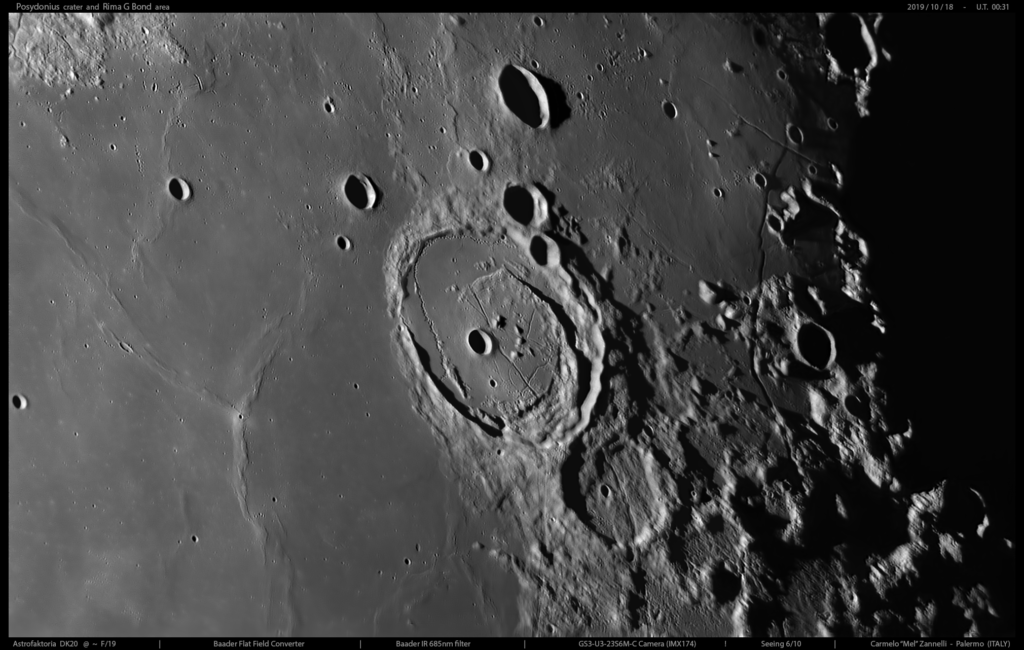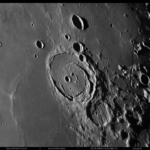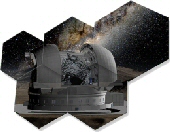Italiano:
Ecco un’altra immagine scaturita dalla sessione di riprese di test del mio nuovo telescopio DK20″, effettuata la notte tra il 17 e il 18 ottobre scorso, in condizioni di seeing sufficiente, ritraente il bellissimo cratere lunare “Posydonius” e la zona ad esso circostante.
Si tratta di un cratere da impatto (del periodo Imbriano Superiore) di diametro intorno a 95 km e profondità di circa 2.3 km, locato alla estremità nord-est del Mare Serenitatis, a sud della distesa di lava denominata “Lacus Somniorum”.
Il bordo di Posydonius è profondo e oscurato, soprattutto sul bordo occidentale, e l’interno del cratere è stato ricoperto da un flusso di lava in tempi molto antichi. I bastioni del cratere possono comunque ancora essere osservati soprattutto a sud e ad est del bordo del cratere e, in misura minore, a nord.
Non esiste alcun picco centrale dovuto all’impatto, ma il fondo del cratere è collinoso e allacciato con un sistema a rille (canali) chiamato Rimae Posidonius. Il fondo è anche leggermente gonfio a causa del precedente sollevamento di lava, che probabilmente ha anche prodotto il complesso di rilles o rimae.
All’interno di esso, si trova un bordo più piccolo e semicircolare (parziale) di un cratere concentrico ricoperto di lava, sfalsato verso il bordo orientale.
Possono anche essere osservati, in questa immagine, altri crateri come il piccolo cratere “Luther” (visibile, un pò isolato, in alto a sinistra con un diam. di 10km), al centro e in alto il cratere “Daniell” (col fondo quasi del tutto oscurato), Il cratere “Mauri C” visibile all’estremo bordo in alto a destra dell’immagine, il cratere eroso e quasi totalmente sommerso “Hall” che ha una curiosa forma ad imbuto rovesciato, il cratere “G Bond” di 32km di diametro (alla destra di Posydonius, anch’esso col fondo oscurato) che da il nome alla lunghissima e profonda “Rima G Bond”, una frattura, qui scurissima che attraversa, da Nord a Sud, tutto il centro dell’immagine; Infine l’antichissimo cratere “Chacornac”, di 53 Km. di diametro, formatosi nel periodo Pre-Imbriano (in media circa 4 miliardi di anni fa), attraversato dalle Rimae Chacornac dal quale prendono nome.
In questa immagine ho anche individuato un paio di candidati Domi che sono in fase di studio ed eventuale conferma da parte del mio amico Raffaello Lena, Lunar Domes Coordinator della British Astronomical Association, che ringrazio per la Sua professionalità e gentile disponibilità.
Grazie per l’attenzione e…. ad maiora semper!
Dettagli Tecnici:
Telescopio Astrofaktoria DK20 @ ~ F/19 – Baader FFC Multiplier – Baader IR 685nm filter – GS3-U323S6M-C camera – Seeing 6/10 in IR band – sito: Palermo @ my personal Observatory.
English:
Here is another image from the test shooting session of my new DK20″ telescope, performed the night between last 17th and 18th October, in fair seeing conditions, centered on the beautiful lunar crater” Posydonius “and the surrounding area.
Posydonius is an impact crater (from the Imbrian-Superior period) with a diameter of 95 km and a depth of about 2.3 km, located at the north-eastern end of the Mare Serenitatis, to south of the lava floor called “Lacus Somniorum”.
The edge of Posydonius is deep and obscured, especially on the western edge, and the inside of the crater has been covered by a lava flow in very ancient times. The edges of the crater can however still be observed mainly south and east of the crater rim and, to a lesser extent, to the north.
There is no central peak due to impact, but the bottom of the crater is hilly and laced with a rille system (rimae) called Rimae Posidonius. The floor is also slightly swollen due to the previous heave of lava, which probably also produced the complex of rilles.
Inside it, there is a smaller and semicircular (partial) edge of a concentric crater covered by lava, offset towards the eastern edge.
In this image, you can see other craters such as the small crater “Luther” (a little isolated, in the upper left, – diam. 10km), in the center and at the top the crater “Daniell” (with the floor almost completely obscured), “Mauri C” crater visible at the extreme edge at the top right of the image, the eroded and almost totally lava submerged “Hall” crater which has a curious revised funnel shape, the “G Bond” crater of 32km in diameter (to the right of Posydonius, also with a darkened floor) which gives its name to the very long and deep “Rima G Bond”, a very dark fracture that crosses the entire center of the image from north to south; Finally, the very ancient crater “Chacornac”, 53 km in diameter, formed in the Pre-Imbrian period (on average about 4 billion years ago), crossed by the Rimae Chacornac.
In this picture I have also identified a couple of candidates Domes that are being studied and eventually confirmed by my friend Raffaello Lena, Lunar Domes Coordinator of the British Astronomical Association, whom I thank for his professionalism and helpfully.
Thanks for your attention and …. ad maiora semper!
Technical details:
Astrofaktoria DK20 telescope @ ~ F/19 – Baader FFC Multiplier – Baader IR 685nm filter – GS3-U323S6M-C camera – Seeing 6/10 in IR band – site: Palermo @ my personal Observatory.


